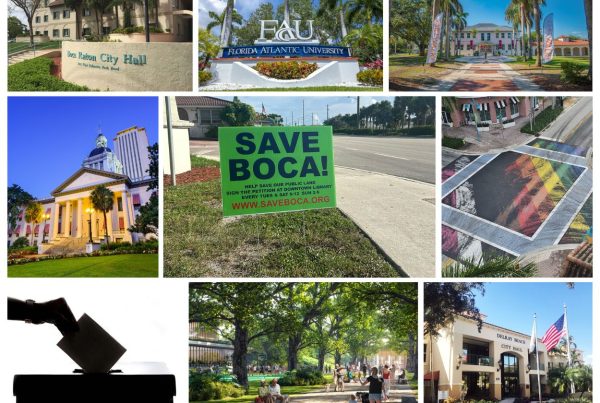
The Chabad saga
Let us hope that in a month there is no reason to wonder if anti-Semitism is at work in Boca Raton.
A curious thing happened at last week’s city council meeting. On the agenda was an application for a development project. The Planning & Zoning Board had approved the project. The staff had recommended that the council approve the project, with some conditions.
Then City Manager Leif Ahnell said he wanted the council to delay its decision because the applicant had failed to provide some information. Something about the floor-to-area ratio: square footage of the building divided by square footage of the lot. The higher the ratio, the denser the project. The issue supposedly had arisen three hours before the meeting. Staff wanted to delay action until May.
None it made sense. Normally, only an applicant asks for such a late delay. The applicant wanted no such delay. Indeed, the applicant didn’t want to wait even a month after having to wait nearly seven years.
The applicant is Chabad East Boca, a congregation of Orthodox Jews that long ago outgrew its space just off Sanborn Square. In 2008, the congregation planned to buy six contiguous properties east of Mizner Park, two of them facing Mizner Boulevard. As Ruvi New, the founding rabbi of Chabad East Boca, pointed out to me this week, there are two busy churches at either end of that stretch of Mizner Boulevard: First United Methodist to the north and St. Gregory’s Episcopal to the south. What could have been wrong with Chabad East Boca joining them?
Something, apparently. After criticism from neighbors about parking and a series of public hearings, the council changed the rules regarding parking for houses of worship in a way that prevented Chabad East Boca’s move.
So to say that Rabbi New is suspicious of what happened last week would be an understatement. “I was most definitely not aware of any problems,” he said. “What happened was highly unusual. Almost unprecedented.”
This time, Chabad East Boca wants to build where La Vielle Maison once served great French food: on the south side of Palmetto Park Road, just east of the Intracoastal Waterway. The property is zoned for the sanctuary, museum and social hall that Chabad East Boca wants to build. Rabbi New said many of the congregants walk to services because they observe the Jewish Sabbath by not operating motor vehicles. Nevertheless, to alleviate traffic problems Chabad East Boca would have underground parking. The congregation could not use all parts of the building at once. Attendance at High Holy Days services would be capped.
Chabad East Boca even had the right team of advocates: lawyer Mitchell Kirschner and architect Derek Vander Ploeg, who are regulars before the council and usually succeed. But just as Chabad East Boca’s potential neighbors were opposed in 2008, they are opposed in 2015. One of them flagged a supposed miscalculation in that floor-to-area ratio, though Vander Ploeg said he met with city staff on that calculation “before we even filed.”
One can assume that the potential neighbor didn’t alert the staff in hopes of making the project better. The idea is to stop the project, or perhaps persuade Chabad East Boca to consider, as some online postings have suggested, a site on “House of Worship Row”—the south side of Yamato Road east of Patch Reef Park.
As Rabbi New explains, however, Chabad congregations are the opposite of mega-churches. They are intensely local, so he can’t move far from the current location. Many congregants, he said, live on A1A near the new site.
Councilman Robert Weinroth, who at first opposed the delay, theorized that any miscalculation might have occurred because a sliver of the property is zoned residential, meaning that it couldn’t be included in the ration. Vander Ploeg said, “It might have been a miscommunication more than anything else.” Councilman Mike Mullaugh, who also first opposed postponement, said the city needs to make sure that there are no “inconsistencies.” If there were, the Planning & Zoning Board approval was “invalid.”
Ironically, if Rabbi New were not asking for 10 feet, 8 inches of added height—which city staff recommended the council approve—Chabad East Boca wouldn’t have needed more than Planning & Zoning Board approval. The city allows the extra height about 30 feet for the main sanctuary, but Chabad East Boca also wants it for the museum exhibit hall due for Vander Ploeg called “functionality” reasons.
Interestingly, just before the council changed those parking rules in 2008, Cooper City in Broward County had to pay a Chabad synagogue $325,000 for keeping it out of the city through discriminatory zoning. Vander Ploeg said Wednesday he has sent the revised calculation to the city. The plan is for the project to go back before the Planning & Zoning Board on May 7. If approved, the project would return to the council on May 27. Will the project get through this time? “I can’t see any reason why it shouldn’t,” Vander Ploeg said. If it doesn’t, Boca Raton better have a very good reason.
Boynton loses yet another one
On Tuesday, we saw another example of why Delray Beach is Delray Beach and why Boynton Beach is, well, Boynton Beach.
Before the Palm Beach County Commission was a recommendation from the staff that the county sell 5 vacant acres of surplus land north of Lake Ida Park in Delray along the east side of Interstate 95. Directly north of that property is a roughly 23-acre site on which a developer plans to build large homes. The developer had offered $500,000 for those 5 acres, on which he would build more homes. The staff liked that option. “As an alternative,” the memo to commissioner stated, “the City of Delray Beach has recently expressed interest in buying the property, which Staff does not recommend.”
Yet the commission voted 6-1 for the sale to Delray. And therein, as the saying goes, lies a tale.
Boynton Beach had first shot at the land, and could have had it for the same $100,000. The city commission, however, turned it down, with Mayor Jerry Taylor saying the city had other needs. That decision led to the sort of sniping that for decades has tainted the commission.
In contrast, the Delray Beach City Commission responded quickly, collectively and effectively.
Last week, commissioners indicated their interest in going after the property. So on Tuesday, it was a Delray Beach commissioner—Shelly Petrolia—not one from Boynton Beach arguing that preserving the land could help create a greenway and ideally could make the site part of the popular El Rio Trail. “Green space is something we don’t have a lot of on the coast,” Petrolia told me.
As the staff noted, there are obstacles to making the land part of a trail system. In 1950, the Lake Worth Drainage District dug a canal that divides the property from Lake Ida Park. A bridge to the northern edge of the park could cost between $250,000 and $400,000. If there’s no other way to get in and out, the developer has said he won’t allow access through his property.
Yet when Delray Beach is at its best, the city tries to find ways around problems. Petrolia says I-95 might provide an easement. The county’s Caloosa Park is slightly north on the west side of the highway. Over time, the developer might realize that a trail would raise the value of the homes. And because donors will put the sale price, buying the land won’t cost Delray Beach.
County Commissioner Steven Abrams, who represents the area, rebutted claims by neighbors that preserving the land would make their lives worse. “On the one hand,” he told me, “they said there’s no way to get to the property. On the other, they said they would be overrun.” As for the theory that those donors would develop their own homes, Abrams counters that the contract will be with the city and will contain restrictions on use.
Truth be told, at least one of those donors may be acting out of enlightened self-interest. Taylor Levy owns a home on the east side of Lake Ida facing the property. He would rather see green than homes, even expensive ones. But if the public benefits, what does that matter? And if the sale brings a big public benefit, we know which city will get credit for trying.
The disappearing Delray easement
By a vote of 5-1, the Delray Beach’s Planning and Zoning Board gave preliminary approval to a new plat for Atlantic Crossing that does not include the Atlantic Crossing easement. The plat must return for a final vote before it goes to the city commission.
The plat now matches the site plan the commission approved in January 2014—when Delray had a different city manager and city attorney—without the staff making clear that the city was giving up the easement. Neighbors believe that the easement, off Federal Highway, would ease the traffic issues from the mixed-use project.
Monday’s night meeting was packed with those who want the easement back in. I’ll have more on this next week.
••••••••
You can email Randy Schultz at randy@bocamag.com
For more City Watch blogs, click here.About the Author
Randy Schultz was born in Hartford, Conn., and graduated from the University of Tennessee in 1974. He has lived in South Florida since then, and in Boca Raton since 1985. Schultz spent nearly 40 years in daily journalism at the Miami Herald and Palm Beach Post, most recently as editorial page editor at the Post. His wife, Shelley, is director of The Learning Network at Pine Crest School. His son, an attorney, and daughter-in-law and three grandchildren also live in Boca Raton. His daughter is a veterinarian who lives in Baltimore.







